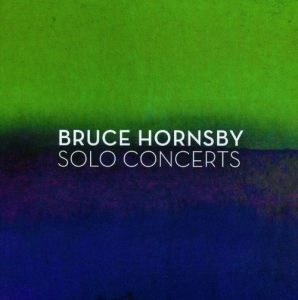I spoke with Bruce Hornsby after one of his solo concerts in 2002, just prior to the release of Big Swing Face. He spoke about asking a lot of his audience, as his continual changes in direction introduced them to music that they may not have been familiar with.
Fast forward a couple of years to London, where Bruce was challenged to play some Eminem on solo piano. Despite some disparaging chuckles from the audience he obliged, before respectfully extending an invitation to “open your minds to somebody truly great”.
My conviction in both cases (I was the culprit for the request) is similar – were it not for these changes in direction that Bruce is “asking of us”, I don’t believe I’d have come across Shawn Colvin, Chris Thile or even Jack DeJohnette in the UK. It’s an education, and the rewards are rich. I now have a CD collection spanning 
A learning experience
We are being taught throughout Bruce Hornsby’s Solo Concerts. The liner notes recognise that this is likely our first foray into Messiaen and his transcriptions of birdsong, or the études (literally, “studies”) of Gyorgy Ligeti. If you like what you hear, I’d encourage you to find Pierre-Laurent Aimard’s interpretation of Ligeti’s Etudes, considered the composer’s finest work. Ligeti’s own summary of his work forms an accurate appraisal of Bruce’s angle:
“These are virtuosic piano pieces, études in the pianistic and compositional sense. They proceed from a very simple core idea, and lead from simplicity to great complexity: they behave like growing organisms.”
Such has been Bruce’s approach to his music, really since we were first aware of him. Here we’re given a fitting documentation which portrays the evolution of songs such as a minor key Mandolin Rain, Valley Road and Night on the Town, all far removed from their original format. They are living, breathing beings, and have grown into what Bruce offers us in this collection.
That growth reflects Bruce’s ongoing pursuit of virtuosity, which has led to some left turns that nobody expected: the “almost no piano” Big Swing Face, changes in the band, a jazz trio and bluegrass projects with some of the giants in both arenas, a musical play and movie soundtracks. All of them challenged us to “open our mind” and embrace something new, and Solo Concerts extends a wealthy abundance of the same.
Conspicuous by its absence is “The Way It Is”, although it is teased within Schoenberg’s Gavotte. This is absolutely the record that Bruce wants you to hear. He will challenge you, teach you, make you laugh or shed a tear.
An ever-changing path
If you needed reminding, this isn’t the record you bought in 1986, or even the show you saw last night. A different inflection, a momentary, improvised diversion or a reinvented song, this one collection rewards repeated listens. On each revisit, you’ll always appreciate something that you hadn’t noticed before. Listen closely and you’ll hear Leon Russell, Grateful Dead and a wide array besides. I swear I heard Wharf Rat in Continents Drift after the third or fourth listen.
This is one avenue in an ever-changing path, and proposes much for us to do our own research on. (You’ll even have heard Ligeti before, if you’ve seen 2001: A Space Odyssey). It’s certainly a very fruitful trip, and yields the most accurate characterisation yet of what Bruce Hornsby is all about.
I’m interested in your own thoughts also – please leave them below and vote on your favourite track. We’re also inviting your rating for the whole collection on first listen.
Thanks for reading!
– Si.
Purchase Bruce Hornsby – Solo Concerts here
